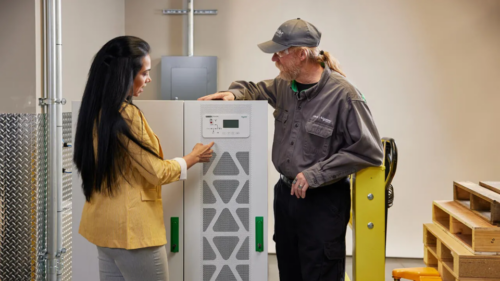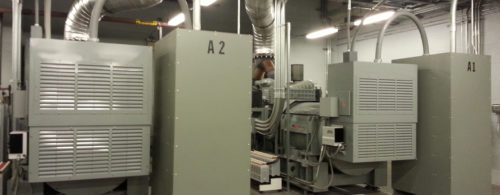Protecting electrical systems in large photovoltaic power plants
As demand for solar energy increases, electrical designers need to understand the requirements for protecting these systems.
A vast amount of literature is available on the physics of photovoltaic (PV) energy conversion, the economy of PV power generation, PV panels and their efficiencies, and equipment to integrate the PV power with the electric utility distribution. This article examines PV power plants from an electrical designer’s perspective.
Large-scale PV power generation seems to have gained significant public appeal. Public acceptance as well as a proliferation of large PV power plants can be attributed to assumptions that:
- Energy is available for free
- There is no adverse environmental impact
- There are no emissions of any kind.
Large PV power plants
The largest PV power plant in the world, located in Sarnia, Ontario, Canada, is capable of generating 97 MW (peak). It occupies an area of 950 acres and uses 1.3 million thin-film PV panels. The expected annual energy output is 120,000 MWh, which, if produced by a coal-fired power plant, would emit 139,000 tons of CO2 annually.
The largest PV plant in the U.S. is the Copper Mountain Solar facility in Boulder City, Nev. This plant is capable of generating 48 MW (peak) and occupies a 380-acre site. The plant uses 775,000 cadmium-telluride PV panels.
In the U.S., the proposed Calico Solar Energy Project to be located in San Bernardino County, Calif., is expected to produce 750 MW of electrical power and 100 MW of solar thermal power. The plant site would occupy 6,400 acres of land belonging to the Bureau of Land Management.
Large PV power plant electrical configuration
A conceptual design of a 10-MW (peak) PV power plant is presented as an example to provide a basis for discussion and illustrate the protection issues in large PV power plants. The peak power rating is based on an assumed solar irradiation of 93 W/sq ft. The average power output is considerably less than this number. However, the equipment and the protective devices are to be sized for the maximum power output.
A typical 110-W PV module is used as a basic building block of the power plant. The module’s electrical ratings are:
- Maximum power at 93 W/sq ft: 110 W
- Rated voltage: 17.0 V dc
- Rated current: 3.14 A dc
- Short-circuit current: 3.95 A
- Open-circuit voltage: 21.0 V
- Dimensions: 5 ft x 2 ft (approximately)
- Active area: 9.4 sq ft.
The example power plant consists of an outdoor installation of PV panels, a dc collection network, an indoor installation of inverters, and high-voltage ac switchgear to connect to the electric utility grid. Generating a peak power of 10 MW would require 91,000 modules.
For a nominal voltage of 595 V dc, 35 PV modules are connected in series to form one 5 ft x 70 ft panel. Each panel is protected by a fuse and a blocking diode (see Figure 1a). The peak dc output of each panel is 595 V, 3.14 A, and 1.868 kW.
As defined in National Electrical Code (NEC) Article 690.2, one array consists of 100 panels connected in parallel. Fuses and the blocking diodes for each panel are located in a dc collection box (see Figure 1b). The output of each array is 186.8 kW, which is also protected by a fuse and a blocking diode.
The outputs of five arrays are collected by the dc collection network to feed to one inverter. The arrays and the inverter constitute one ac module (see Figure 1c). The outputs of 10 ac modules are connected to the utility interconnect substation through 10 step-up transformers (see Figure 2).
The negative dc bus in the dc collection network is grounded. The outdoor part of the PV power plant occupies an area of approximately 100 acres.
PV module I-V characteristics
Each of the 10 ac modules is equivalent to a 1-MW, 480-V 3-phase ac generator (see Figure 2). However, this equivalent generator is not the same as a conventional ac generator. In order to understand the nature of the equivalent generator, it is necessary to understand the current-voltage (I-V) characteristic of a PV module.
The I-V characteristic of a conventional ac generator is a straight line between the short-circuit current and the open-circuit voltage, and the typical impedance is 15%. However, the I-V characteristic of a PV equivalent generator is the same as the characteristic of the PV module, which is the basic building block of this generator. The characteristic of a PV module resembles the leg of a sitting person (see Figure 3).
In Figure 3, normal operation is between points A and B, preferably at point B, at which the power output is maximum. The apparent impedance of the equivalent generator is the reciprocal of the slope of the line AB—in this case, 23.5%. Therefore, while performing a load flow study of the system with the utility tie, each ac module is represented by a 1-MW, 480-V ac generator with a power factor of 1.0 and an impedance of 23.5%.
During a short-circuit condition, the equivalent generator operates along the curve BC of Figure 3. The apparent impedance is the reciprocal of the slope of the line BC—in this case, 387.5%. Therefore, while performing a short-circuit study of the system, each ac module is represented by a 1-MW, 480-V 3-phase ac generator with a power factor of 1.0 and an impedance of 387.5%.
In a conventional ac synchronous generator, the fault current decays from an initial high value to the lower steady-state value because the apparent impedance of the generator changes from the subtransient reactance x"d to the transient reactance x’d, and then to the synchronous reactance xd. This change is due to the currents induced in the damper windings and the field winding.
In the equivalent PV generator, the apparent impedance is resistive and is constant. Therefore the fault current does not decay with time.
In the load-flow and short-circuit studies, the program first calculates the internal voltage of the equivalent generator, which is equal to the terminal voltage plus the voltage drop in the apparent impedance of the generator. The generator is represented as a source of voltage equal to the internal voltage in series with the impedance of the generator. For a load flow study, the internal voltage calculation is:
This value corresponds to 21 V from each PV module. During the load flow study, the terminal voltage for any output current is calculated as the internal voltage minus the drop in the impedance.
For example, if the equivalent generator delivers 90% of its rated current, the terminal voltage is:
While performing the short-circuit study, the internal voltage of the equivalent generator is:
In a short-circuit condition, the terminal voltage is zero. Therefore, the short-circuit current is:
This corresponds to 3.95 A for each PV module, which is the module’s rated short-circuit current.
Applying short-circuit protection
The outdoor PV power plant installation spans several hundred acres. The dc collection network includes several thousand feet of dc cables, either underground or in conduits on the surface. These cables need to be sized and protected in compliance with NEC Article 690.
PV panel, array protection, circuit sizing: NEC Article 690.7 defines the maximum dc voltage as the sum of the rated open-circuit voltage of modules in series. In this case, that value is 735 V, which is the open-circuit voltage of one 35-module PV panel.
Table 690.7 of NEC Article 690 requires ambient-temperature voltage correction for crystalline silicon modules. The maximum circuit current and sizing should comply with NEC Article 690.8 (A)(1): the maximum current output of each panel is 125% of the published short-circuit rating of the modules. According to NEC Article 690.8(B)(1), the circuits from the PV panels to the dc collection boxes in the arrays and the fuses must be sized for 125% of the maximum current, i.e., 156% of the short-circuit currents.
The blocking diodes in the dc collection boxes that protect each panel are connected between the collection box input and the bus that combines the power from the panels. These diodes prevent other PV panels from feeding back possible faults that could occur in cables from the panels to the collection box. Likewise, the blocking diode in the output of the collection box prevents other arrays from feeding into a possible fault within the collection box.
AC module protection and sizing: NEC Article 690.6 defines the protection of ac modules. AC module output circuit protection must comply with NEC Article 240.5 (B)(2). If a fault occurs in the ac cables between the inverter and the step-up transformer, energy from the ac module and the utility could feed into the cable fault through the transformer. Therefore, ac circuit breakers are required at the inverter output and the low-voltage side of the transformer. The low-voltage windings of the transformer must be Y-connected and the neutral grounded so that the circuit breakers can detect and clear ground faults.
Substation transformer protection: Protecting substation transformers requires following standard high-voltage substation design practices. Overcurrent (devices labeled 50/51 in compliance with ANSI standard numbering of protective devices) and differential protection (device 87) must be provided for each step-up transformer. In addition, directional overcurrent protection (device 67) is provided to prevent other ac modules from feeding into a fault in any individual transformer. Reverse power relay (device 32) is not required because the inverter is a unidirectional device. The protection shown in Figure 2 for one transformer is typical for all transformers in the substation.
How much power is available from the sun?
One of the most frequently asked questions is: How much power is actually available from the sun? The solar constant is a measure of the electromagnetic radiation received from the sun on a surface perpendicular to sunlight outside the earth’s atmosphere. It is measured as 126.4 W/sq ft. It varies between 122.7 W/sq ft and 131.2W/sq ft because the earth’s orbit around the sun is slightly elliptical.
Because of atmospheric absorption, the amount of solar energy received at the earth’s surface is approximately 93 W/sq ft. Although PV power plants are designed based on solar irradiation of 93 W/sq ft, this number is not a true measure of how much energy is available from the sun because of these daily and annual irradiation variations. A true measure of the available solar energy for conversion to electricity is kWh/sq ft/day averaged over the thirty days in the month, or over 365 days in the year.
San Luis Valley in southern Colorado is considered to be the sunniest place in the U.S. Here, the average irradiation varies between 604.5 kWh/sq ft/day and 623.1 kWh/sq ft/day in the month of June. Averaged over the year, this number is approximately 418.5 kWh/sq ft/day, which equates to an average power of 17.5 W/sq ft. In New England, this number is as low as 10.1 W/sq ft.
The efficiency of a PV panel is defined as the percentage of solar irradiation converted to electric power. Efficiencies of commercial PV panels vary according to their composition:
- Mono- or multi-crystalline silicon: 10% to 18%
- Amorphous silicon (thin film): 5% to 8%
- Copper-indium di-selenide: 8%
- Cadmium telluride: 7%.
The annual average power expected from a PV power plant using the most efficient panels and installed in Southern Colorado is approximately 3.1 W/sq ft. Therefore, generating an annual average 1 kW would require 326 sq ft of PV panels. Generating an annual average 1 MW would require 326,000 sq ft, or approximately 7.5 acres of active PV panel area.
Peeran is a senior engineer at Camp Dresser and McKee. He is a senior technical specialist, and his experience includes low- and medium-voltage distribution systems, system analysis, harmonic analysis, large motors, and VFDs. He is a member of the Consulting-Specifying Engineer editorial advisory board.
Do you have experience and expertise with the topics mentioned in this content? You should consider contributing to our CFE Media editorial team and getting the recognition you and your company deserve. Click here to start this process.




